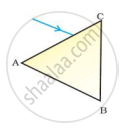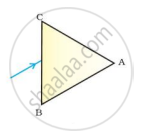Advertisements
Advertisements
प्रश्न
In refraction of light through a prism, the light ray ______.
पर्याय
Suffers refraction only at one face of the prism
Emerges out from the prism in a direction parallel to the incident ray
Bends at both the surfaces of prism towards its base
Bends at both the surfaces of prism opposite to its base
उत्तर
The light ray bends at both the surfaces of prism towards its base.
APPEARS IN
संबंधित प्रश्न
Define the term angle of deviation.
The deviation produced by a prism is independent of the angle of incidence and is same for all the colours of light.
How does the angle of deviation depend on the refracting angle of the prism?
An object is viewed through a glass prism with its vertex pointing upwards. Draw a ray diagram to show the formation of its image as seen by the observer on the other side of the object.
Assertion: The light emerges from a parallel-sided glass slab in a direction perpendicular to that in which enters the glass slab.
Reason: The perpendicular distance between the original path of the incident ray and the emergent ray coming out of the glass slab is called lateral displacement of the emergent ray of light.
A prism ABC (with BC as base) is placed in different orientations. A narrow beam of white light is incident on the prism as shown in below Figure. In which of the following diagrams, after dispersion, the third colour from the top of the spectrum corresponds to the colour of the sky?
The angle between two plane rectangular refracting surfaces of a prism is called as
The diagram below shows the path of a blue ray through the prism:
- Calculate the critical angle of the material of the prism for blue colour.
- What is the measure of the angle of this prism (A)?
- Which colour should replace the blue ray, for the ray to undergo Total Internal Reflection?

State three factors on which the angle of deviation depends.
Name the colour of white light which is deviated the least on passing through a prism.




